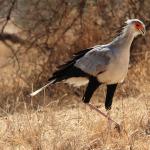The eagle owl is a night bird. Common eagle owl (bird of prey). Report with photographs and video. Who is capable of attacking an eagle owl?
The eagle owl is listed in the Red Book, so scientists seriously fear that the mysterious feathered beauty may be endangered.
The lifestyle of this bird of prey has not been fully studied. The eagle owl lives everywhere except the tundra. Its harsh climate apparently does not please the predator, which thrives in mountainous area, forests and endless steppes.

The eagle owl belongs to the order of owls, so you can often hear it called a great owl. In terms of size, a male eagle owl can reach 0.5 m. Females often grow up to 75 cm.

The weight of the eagle owl is relatively small - only 2 or 3 kg. The wingspan ranges from one and a half to 1.8 m. The flight is almost silent. Making several strokes, the majestic eagle owl picks up the speed it needs, and then soars above the ground for a long time, looking around the area in search of prey.
The color of the eagle owl depends on the area where this bird lives. However, the plumage of this beautiful predator has one interesting feature: the color of the feathers allows the eagle owl to camouflage itself while sitting on a tree. It practically merges with the bark, and this allows the night hunter to sleep peacefully during the day.

If nature had not taken care of such camouflage for the eagle owl, crows and magpies would have pestered him with loud cries. This “popularity” of the eagle owl is not accidental. Being a predator, he is not averse to feasting on other representatives of birds.

That’s why they make noise when they see their formidable enemy in the daytime. In this way, birds warn their relatives of danger.

The color of the eagle owl can be different - for example, golden with dark specks, red or ocher. The eagle owl's sides and belly have a beautiful pattern.

Peculiar business card What makes an eagle owl so special are its large eyes and feathered ears, which are not actually hearing organs.

This formidable predator has sharp and strong claws that are curved down. They leave no chance for the eagle owl's victim to survive.

Lifestyle and character of an eagle owl
The eagle owl cannot be called a “company” bird. He likes to live alone. Sometimes a female and a male can live next door, but each has his own personal space.

These proud birds also hunt alone. The area of the eagle owl can reach 20 m2. He flies around them after sunset. During daylight hours, the eagle owl sleeps, climbing into a thicket of bushes or perching on a tree branch. Night Hunter He also likes to sleep in rock crevices that are well lit by the sun.

Name a Red Book predator migratory bird is possible only with a certain degree of convention. This bird migrates when food supplies have dried up in the inhabited area.

The eagle owl can also go in search of favorable climate harsh winter. If the living conditions suit it, the eagle owl can live in one area throughout its life.

The eagle owl has a powerful and drawn-out voice, to which wolves sometimes respond. The ominous cries of this nocturnal bird are popularly called laughter, hoots or owl sobs. According to ornithologists' calculations, during the night this amazing bird can hoot up to 1000 times.

Nutrition
The diet of a bird of prey includes rodents, birds, hares, reptiles, and large insects. Even hedgehogs and squirrels are caught in the eagle owl's claws!


The formidable hunter is not averse to eating fish. In nature, there is even a fish eagle owl that is larger than the common one.
Typically, the eagle owl settles in places where it can obtain food in abundance. So he is almost never hungry. In addition, he can hide the leftover meat in a kind of hiding place and continue his meal at another time.

It is not surprising that the eagle owl manages to make such reserves, because his prey can be ten times larger than the hunter himself! He is not averse to attacking even a roe deer.
Reproduction and lifespan
Terrible eagle owls - very faithful birds. Having met, they start a family and remain devoted to each other all their lives. The mating season begins in the spring. After mating, the female begins to build a nest. The male does not take part in this matter.

The eagle owl's nest is a small, carefully compacted hole right on the ground. There are also nests in trees. In both cases there is no soft bedding.
The clutch ranges from two to five eggs. A caring female incubates the chicks for 30 days. During this period, the mother does not leave the nest, as the babies may be attacked by a fox or wolf. The male eagle owl takes care of the food.


The chicks do not leave their parent's nest for a month. After 2-3 months they are ready for short flights. Soon the chicks begin an independent life.

In captivity, an eagle owl can live up to forty years. Unfortunately, in the wild, the life of this mysterious beauty can end much earlier.

Photo of bird Owl













The eagle owl is a large bird of the owl order, lives in Europe, Central Asia, and is found in Africa. They prefer mountainous and swampy areas, dense forests, steppes, where they can be well hidden from prying eyes.
Body length 50 - 75 cm, weight 1,200 - 3,400 grams, wingspan 160 - 185 cm. Females are larger than males. It has a round head, large yellow-orange eyes, directed forward and motionless. The beak is dark, short and strongly curved towards the bottom. There are tufts of feathers above the eyes, which many mistake for ears. This is a misconception.
The paws are feathered down to the claws, which are sharp and long. The back is reddish-brown with dark spots, the belly and chest are light ocher in color with transverse speckled stripes. The neck is flexible, he can rotate it 270 degrees in all directions, which makes it easier for himself to see. The hearing and vision of a nocturnal predator are simply excellent. The flight is silent, thanks to the loose and soft plumage. A strong beak and sharp claws catch and hold prey.
They lead a sedentary lifestyle, stick to their territory, and are active at dusk and at night. In general, this bird is secretive, it is not so easy to find it, it hides and camouflages itself well, sitting on tree branches. They hunt in open spaces, flying several kilometers from the nesting site.
It flies slowly and looks for prey. Or it may sit on a branch, but when it hears rustling in complete darkness, it will unmistakably determine the location and grab the victim. They feed on mammals: mice, hedgehogs, hares, hamsters, gophers; birds - crows, black grouse, ducks. It also eats insects, various beetles, spiders, and catches lizards. In one meal, it can eat up to one kilogram of prey. By winter, it accumulates fat equal to 20% of its weight. Such supplies will be very useful on cold frosty days.
The breeding season starts early. Offspring are born once a year. In March-April, males begin to scream loudly, inviting females; their “songs” can be heard at a distance of 3-4 km. He hoots loudly (ooh-ooh-ooh), then laughs, such a serenade somehow makes you feel uneasy, especially if you hear these sounds in the dark. But the female likes it, she responds to the invitation with a cry, and then flies to the male. Groom dancing mating dance, stretching out and pressing his wings to his body.
Soon the female looks for a secluded place on the ground among the bushes or under a dense spruce forest. Having dug a small hole, she will lay 2-4 white round eggs. Only the female incubates, the male feeds her. In a month, chicks will appear, dressed in gray-white fluff. Both parents feed the offspring. At one month, the moulted chicks leave the nest, but are under the watchful gaze of their parents. They don't know how to fly yet. Eagle owls, protecting their clutches and chicks from predators, fearlessly attack the enemy, hiss, peck and often emerge victorious. At the age of three months, the chicks can get their own food on their own, and they can already fly well. But these cute pranksters constantly beg for food from their parents, and, of course, receive it.
Species: Bubo bubo Linnaeus = Common Eagle Owl
Spring, March... Even before the dawn goes out, a dull, mysterious “gguuu-gu” is heard over the wild river tract from a high, steep bank. Then, with a short pause, another shout sounds, then another.
It was the owl who began his spring “singing.”
In the silence of the night, these clicks can equally inspire anxiety and admiration. The gloominess of their owner, an uncommunicative and secretive creature, is discernible in them, but there is neither melancholy nor threat in them. No one responds to this hooting, but the eagle owl does not stop repeating it, changing intonations from time to time. He will be silent for a while and then begin to whine again. And so almost until light. And the next night it will hoot there, and somewhere in that place there will be its nest.
The eagle owl does not build nests. White eggs are simply laid on the ground, and later white puffy owls lie on the bare ground. The eagle owl is most comfortable with small caves, old gullies in the walls of cliffs, into which one cannot look either from above or from below. Sometimes a couple settles into an ownerless building of an eagle, osprey, or bald eagle.

The eagle owl can live wherever there is prey and where it is not pursued by humans. Although it can be compared in strength to eagles, the eagle owl is distinguished by its nocturnal lifestyle and the presence of long and sharp claws, against which there is no protection. Therefore, hedgehogs are almost the easiest and most common prey for the eagle owl. It is impossible to pluck or skin a hedgehog, so the eagle owl simply tears the victim into pieces and swallows them along with the quills. The eagle owl also does the same with large horned stag beetles, which he swallows whole, along with their horned weapons.
It was noticed that there are no crows near the eagle owl's nesting site, as they are the eagle owl's favorite prey.
Therefore, if a crow finds an owl during the day, then, having gathered in a huge flock, it begins to actively attack it. At night he will deal with the one who catches his eye first, and sometimes even during the day he will not miss the right opportunity to settle scores.
A completely reliable fact is known when an eagle owl, at noon, in the bright sun, and even in front of many people, grabbed a wounded crow in flight. From the only pellet that hit her, she did not croak, nor did she change course, but, having stopped flapping her wings, she glided on them, slightly descending towards the not yet covered alder forest, where she was heading. And when there were seventy meters left to the alder tree, a huge eagle owl quickly flew out of its thicket and took its victim in the air. He heard a shot, saw people, but, noticing a momentary disruption in the crow’s flight, he decided on a sure attack.
In general, the eagle owl, when hunting, catches everything that is suitable for food and with whom it can cope. Unfortunately, the idea of birds of prey, which can catch ducks and hares, as pests and intolerant enemies of the hunting industry, is extremely persistent. Wherever the eagle owl lives, its diet has long been studied in detail and is known full list
In the warm season, the eagle owl practically does not touch such large prey as an adult hare. In winter, the choice of prey is not the same, and it can be more profitable to find such prey that you can be fed for several days.
Therefore, having taken a hare in winter, which cannot be dealt with in one sitting, the eagle owl does not leave the prey for several days until it finishes it off to pieces. You can’t hide what you haven’t eaten, not only because crows, foxes or magpies will find it and steal it, but more because even earlier, the night frost will turn the tasty hare meat into a stone that cannot be beaked in an hour. So the eagle owl covers the half-eaten hare, like with skirts, with its lush feather, sitting on it and, probably, warming it a little with its own warmth, just as it warms chicks. Having reached the headless carcass to some nearby bush, so as to be less visible during the day, the eagle owl does not move on it until the evening.
A well-fed eagle owl does not mind any frost, since he is dressed warmly: the eagle owl even has feathered fingers right down to the claws. And heat losses are negligible: a dormant bird loses almost only the heat lost during breathing. The almost two-meter wingspan of an eagle owl seems a bit short for such a large bird. The length of its folded wing is almost the same as that of a kite, with a weight two and a half to three times greater than that of that one (an eagle owl weighs up to 3 kilograms). But the width of the wings is such that the eagle owl can reach maximum speed from a standstill. The strength of the wings allows their owner to easily carry a well-fed mallard or heavy hedgehog . A wild owl released in the room knocked out a double window glass
and quickly flew out without dropping a feather, as if there really was no obstacle in front of him. And at the same time, the flight of a huge bird is as silent as that of other night owls, due to the special structure of flight feathers - the same as that of the long-eared owl, which is slightly similar to its brother. In this article we will talk about the largest owl living throughout the territory of the former USSR - eagle owl
. Today, the eagle owl is under threat of complete extinction, which is why it is included in the pages of the Red Book of Animals of Russia.
The eagle owl is often classified as a harmful animal that reduces the number of hunting resources. These ideas are easily refuted by the fact that eagle owls do not eat that much - their daily diet is no more than half a kilogram of meat. But at the same time, we can say with confidence about its benefits for Agriculture, as it eats large quantities of rodent pests.
The eagle owl lives almost throughout the entire territory of the Russian Federation, in dark forests of any type - both mixed and coniferous. The main thing is that these forests are located away from people. It can be found in the taiga, as well as forest-tundra, steppes and deserts. It easily adapts to both northern frosts and the climate of sultry deserts.
This is the biggest owl. The body length of males is from half a meter to 70 cm, weighing from 1.5 to 3 kg. Females are somewhat larger. The wingspan of an eagle owl reaches 1.5 meters or more. The color of the plumage depends on the area in which it lives. It is very difficult to notice both during the day and at night; its color seems to “merge” the silhouette of the bird with the tree trunk. And camouflage is very important for him, since during the day he becomes defenseless, and he can be bothered by crows, magpies and other birds circling around him and screaming. This bird has very developed paws and claws, with which it grabs prey. The claws are very curved and sharp as a knife. The eagle owl digs them deeply into the body of the victim, touching the main organs, and the prey loses the ability to resist.
A few words need to be said about the flight of the eagle owl. He flies silently. You can hardly hear how its massive wings cut the air as it flies. The even and smooth flight of the eagle owl, attentive listening and peeking out at its prey make one admire this bird. He will flap his wings a few times and then fend off the wind for a while, as if resting.
Its prey includes voles, other small rodents, brown and hare hares, and squirrels. It also attacks grouse (grouse, hazel grouse, black grouse, etc.), geese, ducks, seagulls... The eagle owl can hunt birds in flight. He can catch up in the air with even the fastest bird living in our area. When there is a lack of food, the eagle owl also attacks larger and more dangerous animals. It can attack both martens and ferrets. True, he does not always cope with them, so sometimes he gets seriously injured. There are known cases of an eagle owl attacking a fox, which died from its claws. This large predator can also attack larger prey - musk deer or roe deer. If he cannot eat everything, he hides the leftovers in a secluded place.

This flying predator is not averse to feasting on bats, as well as its closest relatives – common owls.
The eagle owl leads a sedentary lifestyle, flying to other places only due to lack of food. And basically lives in the same habitat throughout its long life.
The mating season of eagle owls begins in early spring. After mating, the female builds a nest for herself. It should be noted that the same pair nests in the same place year after year. The nest is located on the ground and is an ordinary hole of small depth, without any bedding. Sometimes eagle owls can nest in a tree, occupying a ready-made, suitable-sized nest of other birds. The female brings no more than 4 eggs. The eggs are almost the size of chicken eggs and white in color. The female incubates them for just over a month, after which chicks weighing 50-70 grams are born. Both parents feed the chicks. In the first month, the eagle owls are afraid to leave the nest, but in the second month of life they can move 100-150 meters away from it. After 3 months, they can fly like adults, but they still continue to depend on their parents, who still feed them.
Neither wolves nor other predators try to approach the eagle owl's nest, since the parents bravely protect their young eagle owls, attacking uninvited guests.
Today I would like to talk about one of the largest birds of prey in our country, namely the common eagle owl.
A little biology
The common eagle owl (lat. Bubo bubo, Old Russian scarecrow) is a bird of prey from the owl family, one of the largest representatives of the order of owls. The only way to confuse an eagle owl in nature is with a fish eagle owl, from which the former differs: in significantly more intense (saturated) pigmentation of the plumage and iris of the eyes, feathered paws and a truly owl-like silent flight. The eagle owl's claws have two cutting edges, and not one blunted one, like those of fish owls, since the eagle owl, at the moment of taking possession of the victim, needs to inflict as significant wounds on it as possible. Let us note here that the eagle owl looks like a huge long eared owl. The latter is reliably distinguished from the eagle owl by its small size.
A large bird of prey, the length of the bird is 60-75 cm, the wingspan is 160-190 cm, the weight of males is 2.1-2.7 kg, the weight of females is 3.0-3.2 kg. In addition to general size, sexual dimorphism in eagle owls is quite clearly expressed: in most cases, females are noticeably larger than males, and is also manifested in the form of “feather ears” characteristic of the bird: in males they are more straightened than in females. The elongated feathers of the head sticking out on the sides, which many mistakenly mistake for ears, help the bird to blend in with environment during daytime rest.
Where eagle owls live, their calling calls can often be heard. Most often it is the male who gives the voice. His calling cry is a low (main load in the region of 150-400 Hz), double hoot, with emphasis on the first syllable and lasting about 0.7 s, something like a dull “tu-oo” or “oo-oo”, with a lower and a short second syllable. With active vocalization, screams follow one after another with pauses of 8-10 s. Strangely, this cry at a distance of 500 to 100 m is perceived approximately the same, so it can be difficult to determine the distance to the bird based on its strength. In mossy swamps and wastelands of the taiga zone in calm weather, the cry of an eagle owl can be confidently detected by a person from a distance of 1-1.5 km, and under ideal conditions, even 3-4 km away. It has been noticed, however, that in deserts the voice of eagle owls is much quieter, and it can be heard no more than a kilometer away under the most favorable conditions. In a calm situation, the calls of the male and female are similar, although in the latter it is slightly higher (about 250-450 Hz) and more variable in structure and pitch; when excited, it sometimes sounds like a monosyllabic squeal. There is evidence that during paired vocalization, the female’s voice can be one third higher in frequency than the male’s.
During the time corresponding to the spring current, eagle owls often scream continuously for 30-50 minutes or more in a row, and after a short silence they resume “singing” again. Sometimes one bird calls more than 1000 times during the night. But usually the greatest vocal activity occurs half an hour before dawn, and the birds fall silent as the sun rises. Eagle owls vocalize most readily in low frost (up to -5°), clear, windless weather. At the height of mating excitement, paired singing can also be heard in the nesting area of eagle owls. At the same time, the calling calls of the male and female alternate.
Ornithologists note more than 10-12 different vocal reactions in the eagle owl. Of these, the meaning of only a few is clear so far. Thus, when flying out to hunt, an eagle owl often announces the surroundings with a powerful buzz. This is a somewhat drawn out ordinary cry of an eagle owl. It can be assumed that in this case one of the pair members informs the other about the direction of flight for food. But practically the same signal warns the chicks of danger and, upon hearing it, the owls freeze for a while.
Couples are monogamous. Beginning in October, the young male wanders from place to place, periodically calling a female from the top of a tall tree or other dominant eminence - these loud sounds, known as hoots, usually indicate the presence of a bird in the area. The timing of vocal activity varies: according to European sources, its peak occurs in December and January, according to Russian sources - in February and March. Non-solitary males also behave in a similar way, but in their case the “search”, as a rule, begins later and does not take too much time, since a sedentary female is nearby. In any case, the marriage ritual is repeated from year to year, couples are formed as if for the first time.
IN final stage both birds shout to each other, while the male most often holds his body straightened horizontally with a raised tail and slightly spread wings, and the female bows in time. Elements of courtship may also include mutual bowing, touching each other's beaks, and ceremonial feeding. Mating activity ends with the laying of eggs. There is no nest building; only pellets can play the role of additional bedding. Eggs are laid in a depression in the ground, often under the cover of spruce branches, between roots and fallen trunks, among a scattering of stones or in another similar secluded place. Often the nest site is a hard-to-reach rocky ledge, a crevice, a ravine, or even a small cave. In rough terrain - in the mountains, on steep river cliffs, in ravines and ravines - the bird prefers sunnier southern slopes. The same place is sometimes used repeatedly, which is especially typical for steep rocky slopes. Eggs are laid early, when there is still snow. A complete clutch contains from 2 to 6, most often 3 or 4 eggs, which are born at intervals of 2 to 4 days. The eggs are white with a rough shell, round in shape, size (53-66)-(45-54) mm. The incubation period of one egg is from 32 to 35 days. The female incubates exclusively, while the male obtains and brings her food.
The chicks hatch in the same order as the eggs were laid, but unevenly: sometimes two chicks are born almost simultaneously, and sometimes several days apart. As a result, several chicks can be found in one nest, very different from each other in size and size. general development. Newly born owlets weigh about 60 g. They are blind and helpless, covered with thick whitish-ochre down. At the age of 4 days the eyes open, at about 20 days the initial almost monotonous downy plumage is replaced by a more colorful plumage of small downy feathers (known as mesoptiles), in which White background interspersed with many brown spots and stripes. Around the same time, the greatly grown and strengthened chicks are able to swallow small prey whole. Younger ones often cannot compete with older ones for access to food and die of hunger or become victims of cannibalism. The adult female almost does not leave the offspring for the first three weeks, butchering the prey brought by the male, feeding and protecting the chicks, and then helps the male in obtaining food. The length of time the chicks stay within the nest varies: if on a flat landscape they tend to explore the territory on foot at the age of 22-25 days, then on rocky ledges they stay together for 5-7 weeks before the prerequisites for flight appear. By the end of this period, the chicks are able to flutter several meters, at the age of two months they overcome a 100-meter distance, and after another 20-30 days they become independent. They beg for food from their parents for some time before finally dispersing. Puberty of young eagle owls occurs in 2-3 years
Eagle owl chicks hatch completely covered with soft, thick white-ochre down. This tone appears most intensely around the eyes, on the forehead, as well as on the wings and tail. The mesoptile, which replaces the first downy outfit, is just as faded, but densely dotted with blurry brownish stripes, creating a more defined, although also fuzzy, transverse pattern on the chest and sides. The legs and toes are feathered in all stages of growth. Their plumage is monochromatic, light beige.
The coloration of adult birds is extremely variable in the intensity of pigmentation of the dark areas of the feather. Thus, from a distance, Western Siberian birds, especially perched ones, look almost white, while many eagle owls from the European part of their range are intensely buffy-brown at the base with numerous rusty-dark and black streaks. In all cases, the top of the head and chest are most intensely colored; greatest number dark feathers are characteristic of the top of the wing and shoulders. The tail feathers and flight feathers are striped, with a regular alternation of ocher and brown tones. The facial disc is relatively poorly developed, has a relatively light, grayish-brownish color with a barely noticeable pattern and sharp black stems at the throat.
The plumage of the eagle owl is soft, loose, clearly designed for the silent flight necessary for this predator to suddenly appear in front of the prey. Even the main feathers of the wing - the primary flight feathers - have fanned edges. In addition, these feathers have a special curve of the fan, which minimizes the whistle of the air being cut during flight and the rustling noises that arise from the friction of the feathers against each other. The shortening of the primary notches also contributes to quiet flight, while simultaneously increasing the total load-bearing surface of the already wide and long wing. That is why the flight of an eagle owl always seems easy, as if somewhat relaxed, in comparison with other large birds.
With a sufficient food supply, the eagle owl does not leave its area throughout its life, the area of which varies from 15 to 80 square meters. km. The eagle owl belongs to purely crepuscular and nocturnal animals. This is indicated by the structure of its feather cover (softness, allowing for silent flight), foraging techniques (designed not to pursue the victim, but to suddenly appear in front of it), and finally, its low voice. In all cases, during daylight hours they are inactive and, on the contrary, are active at dusk and at night. The eagle owl's hunting range is quite large. In the hunting area, the eagle owl behaves quite stereotypically. Before sunset, he flies away from his day’s place in a leisurely search flight, almost above the ground itself, to the place of the upcoming hunt. Sometimes luck accompanies the owl immediately, and then he, like a harrier, falls on the victim. In the approaching twilight, you can see how an eagle owl flies over some body of water in search of a coot or duck, which it prefers to catch on rafting. But more often, after flying for about 1 km, the eagle owl sits on an elevated platform, waiting for the victim to appear. Combing the area from the air - characteristic eagle owl hunting.
The eagle owl usually grabs prey from the ground, but often overtakes birds on takeoff. A large prey, the size of a white hare, is given to him with obvious difficulty. He grabs her by the head or body with one paw, and with the other, trying to stay in place, he tries to cling to the grass or bushes. The eagle owl dismembers large prey into pieces, tearing off pieces and eating them indiscriminately - the meat of the victim is absorbed mixed with wool, intestines, etc. If the prey is not eaten in one go, the eagle owl hides it.
Found throughout Europe, North Africa and Asia south to Hindustan and Indochina. The eurytopic nature of the eagle owl is obvious and well known. With almost equal success, it breeds offspring in the taiga zone, steppes and deserts, lives in lowlands in river valleys, in rocky gorges. When nesting in the mountains, this eagle owl can be found at an altitude of up to 4700 m. Strict biotopic assignment is also not typical for this bird. Obviously, in all cases the determining factors are only the availability and accessibility of food.
1. A well-fed eagle owl does not mind any frost, since he is dressed warmly: the eagle owl even has feathered fingers right down to the claws. And heat losses are negligible: a dormant bird loses almost only the heat lost during breathing.
2. It is believed that the Romans lost the battle of Hannibal at Cannae largely because owls screamed in their camp at night. This was a bad sign, and the morale of the soldiers left much to be desired.
3. In terms of the strength of its voice and the impression it makes, it is also difficult to confuse the eagle owl with any other nocturnal bird. The power of his cries is such that even wolves respond to them
4. Eagle owls, unlike other birds, have 3 pairs of eyelids.
5. This silent and formidable predator with powerful sharp claws on its paws can hunt not only small rodents, but also hares, geese and even young wild boars. An eagle owl's prey can exceed the size of the predator itself by 10 times!
6. In captivity, an eagle owl can live up to 40 years. Although in nature this period is much shorter.
7. Hunters say that an eagle owl intercepts shot game in the air.
8. In its territory, the eagle owl attacks other owls and birds of prey, for example, buzzard and kestrel. Sometimes he manages to overcome even such large birds, How snowy owl or a young white-tailed eagle.
9. The tarsus and toes are feathered, which is also one of the defining features (the fish owl has bare toes). A sitting bird usually holds its body straight, but when calling, it bends it forward and stretches its legs.
10. Chicks, at the age of about a month, in normal life situations can move 100-200 m from the nest.
11. crows, usually noticing an eagle owl at rest, circle and scream above him; magpies scurry nearby with an alarming chatter.
12. An eagle owl can turn its head 270 degrees.
13. The type of structure of an owl's foot is called zygodactyl. This means that two fingers face forward and two fingers face back. This helps owls easily catch prey. Sometimes the third toe may rotate forward to make the bird more comfortable on the perch.
14. Owls don't have eyeballs. Their organs of vision should rather be called eye tubes. They have an elongated shape, and they are held in place by sclerotic rings - bony structures in the skull. Because of this, owls cannot move or roll their eyes, and this is why their neck mobility is so increased, but we will learn more about this. The leading edges of the wing have a hard edge that reduces noise, and the rear edges have a soft edge that helps reduce turbulence. This also reduces the noise from the wings and makes the flight silent.
15. In eagle owls, the outer ear consists of folds of skin. The ears are located slightly asymmetrically, which allows you to accurately determine the direction of the sound source. The owl's sound detection accuracy is phenomenal - less than one degree vertically and horizontally.
16. Eagle owls can hear sounds with a frequency of 2 Hz (humans - at best, from 16)
17. The strange love of owls is expressed for the meat of hedgehogs, which dominates the eagle owl’s diet, if only hedgehogs are found. While many species are wary of hedgehog spines, this owl uses its massive, scaly talons to pull the hedgehog's spines away.
18. On the island of Wolin in the Baltic Sea, eagle owls born in captivity are released.
19. As an eagle owl ages, the color of the iris of its eyes also changes. In a young bird it is light yellow, and over the years it acquires an intense dark orange color.
20. From Latin the name is literally translated as “OWL OWL”
For those who are too lazy to read







